General Rope Rigging for Rescue Workshops
ARTIFICIAL HIGH DIRECTIONAL WORKSHOP
-
AHDW
ARTIFICIAL HIGH DIRECTIONAL WORKSHOP -
(See Current RTR Open Enrollment Schedule for when/where this program is offered)
Read (or print) the most recent color information flyer on this workshop: Utah Venue or Ontario, Canada Venue
Recognizing the need for advanced-level train-the-trainer instruction on the use of any constructed frame or "artificial high directional" (AHD), RTR is now offering the 7 day ARTIFICIAL HIGH DIRECTIONAL WORKSHOP suitable for fire emergency and rope access professionals. From Reed Thorne, the co-designer of the Arizona Vortex, this AHDW is meant to assist the rope rescue instructor with information relative to the use of manufactured high directionals. This workshop would be suitable for ANY manufactured or improvised high directional (not including wood frame) including the Larkin Frame, SMC Terradaptor, or Ferno Aracnipod (students requesting training on these AHD are required to bring these devices with them to their program). This program concentrates on constructed frames in general and is not intended to teach highlines, advanced pulley systems, or offsets (although some of these are touched upon). Physics, as it relates to high directionals, is covered in an extensive manual and several lectures. The AHDW is a hands-on workshop on the use and correct implementation of artificial high directionals (AHD) for industry and wilderness settings. The AHDW is also well suited for teaching rope access professionals the benefits of constructed frames in their work.
BELOW: Two testimonials about the AHDW. One in South Australia (below) and one in Colorado.
The Fort Collins Fire Department had the great opportunity to assist with bringing Reed Thorne of Ropes That Rescue (RTR) out for a five day AHDW-5 class from November 16 through 20, 2020. The decision was made to bring RTR to Colorado because it was time for Colorado fire departments to discover the true and dynamic versatility of the Arizona Vortex which Reed Thorne helped design in Arizona, as well as discover the true ‘ART of Clean Rigging’ which RTR espouses.
The Ropes That Rescue Artificial High Directional Workshop is for those that have the desire to drive their AHD framing skills to the next level. Even during this class when you think you couldn’t go to higher levels of rigging, the curriculum takes you even farther.
As a spectator of the 2020 AHDW-5 class I got to sit back and witness the transformation of competency within the students. I watched how cultural norms shifted before my eyes. I watched a group of individuals become a team of rigging machines. I was so amazed with the level of competency that Reed Thorne was able to reach with 12 people in a 5 day period.
This class was not all advanced rope technicians and I had the opportunity to ask question of the students. I asked a student named Joey what he learned. The student literally looked at me and said,
“humility”, and then went on to say that he was amazed in what he learned, and what he didn’t know about this perfect devise called the Arizona Vortex, as well as how excited he was to keep learning more about it.Joey was one of many student I got the opportunity to talk to after this class. The questions I would ask where, “what did you learn?”, “How did it change your ideas of fundamental rigging?”, “How much fun did you have?”.
Each answer I got was a lot like Joeys, but one of the student also talked to the transformation of their rigging fundamentals. Aaron said: “I always assumed rigging was rigging until this class, the intricacies that I learned in this class from small changes in just the way you should place carabiners into the AZORP head to the big picture of seeing full transitional, paradoxical luffing systems, rigging pods, and being able to actually picture them as Reed Thorne is explaining them.”
He continued “I suggest everyone wanting that next level to go to this class!! I want to go two or three more times.”
The only thing I can say as a person that is already bought into the curriculum is DO IT! This class is becoming a fundamental standard for our advanced rope technicians. We hope to continue the classes with greater and better venues in the future. Till then keep rigging, and a big thank you to Reed. You are a great resource to us all, and I hope to keep watching your symphony for many years to come.
Tyler Giliotti
December 17, 2020More from "down under":
G'day Reed & Len, (NOTE: Len Batley is the Senior RTR Instructor in Australia. Read about "Lenny" HERE)
Thank you very much for a fantastic 7 days of advance rigging and building complex Artificial High Directional (AHD) configurations. I thoroughly enjoyed the course and it was an absolute honor to be part of the first Australian AHD Workshop and rig some Gucci setups with like-minded motivated people.
Now with a few days of reflection under my belt, including reading over my notes, looking at photos and allowing my brain to absorb the things learnt during the course, I can confidently say I have greater understanding of the Vortex’s capability and performance. Essentially, any set up with the Vortex is possible as long as the rules of physics are correctly applied. If anyone questions that statement, show them some of the configurations we rigged and dare them to say otherwise!
The highlights of the AHD Workshop that particularly stand out for me include the intensity of the rigging, guy plane considerations and jamb poles. If I had a preference, I would normally choose to rig in a wilderness setting over an industrial environment but the Old Royal Adelaide Hospital rigging was next level.
Prior to the AHD Workshop I had not been exposed to many jamb pole configurations and I feel the skills I have learnt and been exposed to on this course will better prepare me as a Rescue Officer for the Metropolitan Fire Service. ‘Knowledge doesn’t weigh very much and is hard to leave behind!’ Like all Ropes That Rescue courses I complete, my mind now wonders into the future possibilities in terms of application of the Vortex, trialling different concepts and of course aiming to continually get better at my craft and the art of clean rigging.
Returning to work I have completed several days of facilitating ‘plate spinner’ rope rescue training with the firefighters in Adelaide. Let me tell you it is harder to get excited about a tandem prusik belay than it is about doortex frame. In saying that a tandem prusik belay does still excite me!
For mine, the course was perfectly balanced between theory and practical elements. Reed, I commend you for the time and effort you have put into your Mac Keynote presentations. Graphics like the overlaying of a resultant force or a guy plane on an image cement the learning outcome you are explaining to the group and they look first class. Furthermore, the theory workbook is very detailed and I can only imagine the hours you have dedicated to developing it all.
I believe the discussion had by the class on day 3 when we set up the Easel A-Frame and modified the rigging for a ‘go’ or ‘no go’ was the perfect conduit between the theory and practical days. It really set the scene for bigger and better things.
Reed and Len, I want to send a big thank you once again for the time and effort you have invested into developing my rope rescue knowledge not only on this course but the past also. Your teaching styles accommodate each other perfectly to form a great instructor team. You both have incredible patience. Watching students fumble their way through rigging problems must be frustrating at times but we all have to start somewhere. As Reed said on day one “we are not born with the skill to rig. It is a learned behavior.”
Reed, I am sure you are aware, but if not, you have created quite a legacy in Australian rope rescue. Many people enroll in a Ropes That Rescue course to experience Reed Thorne in the flesh. I enjoy seeing how you go about your business and am thankful that you made the effort once again to travel down under to spread the Ropes That Rescue ethos to indoctrinate us into the rope rescue culture.You bring this incredible subject knowledge, infectious energy and amazing ability to communicate with passion in front of a class, even after being jet lagged. Your attention to detail is second to none and this is coupled with an amazing ability to conceptualize a AHD system prior to the first bit of rope being tied.
Len, it is nice to see the person who has had the most influence and mentored my rope rescue career working under/with their mentor. You have influenced many rope rescue personnel Australia wide and have a fantastic ability to explain Ropes That Rescue concepts while bringing an alternative way to look at the challenge ahead. I know your passion for rope rescue is to influence and educate emergency responders so thanks for sharing your knowledge with all. Thanks also for all the behind the scenes organizing you have done to make this course possible. Your networking in terms of securing locations to train is much appreciated. I now related the old Adelaide Dental Clinic as Jamb Pole Country! Please pass on another big thanks to Cathy for opening up your home, providing us all with an amazing feed and allowing us to talk rope rescue over several IPAs or a glass of South Oz Shiraz. Shit yeah!
A real testament to the Ropes That Rescue programs is that courses regularly sell out and yet there is no official nationally recognized qualification associated with them. That indicates to me that the personnel that enroll in these courses do so because they want to be challenged, better their skills and not just tick a training requirement box. Reed mentioned that he educates to the ‘highest’ common denominator rather than the typical fire service ‘lowest’ common denominator. That for me is exactly what I crave in a rescue course and has allowed me to network with others that feel the same. It is for this reason alone that I think the AHD Workshop could certainly be run in Australia again.
Thanks once again to all. Merry Christmas.
Yours in Rigging,
Joel Graham
(December 2018) -
AHDW key points
KEY POINTS
Read (or print) the most recent color information flyer on this workshop: Utah Venue or Ontario, Canada Venue
-
Physics of high directionals
-
Extensive knotcraft for securing the Arizona Vortex in advanced setup positions
-
Use of high directionals to eliminate or reduce edge forces
- Proper set up (A to Z) of any manufactured or improvised AHD
- Anchoring the Arizona Vortex for static and dynamic events
- At-the-edge, and back-from-the-edge AHD set up.
- Guying the improvised and manufactured AHD's with rope/webbing
- Working with the Arizona Vortex bipod (A frame or Sideways A frame); guying concerns etc.
-
Working with the Arizona Vortex monopod (gin pole); guying concerns etc.
- Arizona Vortex Lazy leg SA frame set ups (optional)
- Active (luffing over the edge) and passive guying of bipod Arizona Vortex
- Rigging Arizona Vortex pods and A pods
- Strengthening overly-extended legs on the Arizona Vortex
- Use of the SkyHook® rope capstan winch with the Arizona Vortex
-
Similar and paradoxical motion when entering the hazard zone under any AHD at the edge
- Arizona Vortex V frame and double A frame set ups
- Cantillevered Arizona Vortex set ups
- Tandem AHD's
- Much, much more...
-
The AHDW teaches frames derived from the Rock Exotica Arizona Vortex® and AZORP® head accessory: (Note: some of these set ups require two or more AZV kits)
- Tripods (equal sided)
- Focused floating rigging pods and bipods (with Skyhook® capstan winch or not)
- Easel A frames
- Cantilevered easel A frames
- SA (sideways or in-line) A frames
- Cantilevered A frames and SA frames
- Paradoxical luffing of A frame (active guying)
- Double A frames
- V frames
- Tandem frames (combo AHD's)
- Skyhook® capstan winch usage (as time permits)
- Generator and 110 volt power head
- Cordless 28v drill
- Hand crank
-
-
AHDW Details
7 Days - Some days are up to 10 to 12 hours in lengthModerateClassroom 30%, Practicals 70%Prerequisites: None (Prior rope rigging experience strongly recommended)
Read (or print) the most recent color information flyer on this workshop: Utah Venue or Ontario, Canada Venue
Get: RTR Application
Go to: Registration Information
Find out tuition and when and where offered: See Schedule -
AHDW Photos
ARTIFICIAL HIGH DIRECTIONAL WORKSHOP PHOTOS
From Ropes That Recue collection. All photos copyright RTR ©1999/2022Read (or print) the most recent color information flyer on this workshop: Utah Venue or Ontario, Canada Venue
Below: An Arizona Vortex SA frame used in Deception Gulch near historic Jerome, AZ in 2014

Below: An Arizona Vortex easel A frame (distant) and AZORP rigging pod (foreground) used in Deception Gulch near historic Jerome, AZ in 2014

Below: The abandoned Jerome Hotel in historic Jerome, AZ makes the perfect AHDW venue for constructing the Arizona Vortex "Doortex" with the "Sedona Penetrator". This photo is from 2014 Industrial Rescue Workshop which parallels the AHDW in some ways.

Below: A Skyhook® capstan winch stand constructed from the Arizona Vortex at Granite Dells AHDW in 2014.

Below: Arizona Vortex program at Mt. Arapiles, Victoria, Australia in 2007.

Below: 2014 "Watson Frame" (named after Watson Lake Dam) in the Granite Dells near Prescott, Arizona. Three Vortex kits were used in the making of this articulating frame.
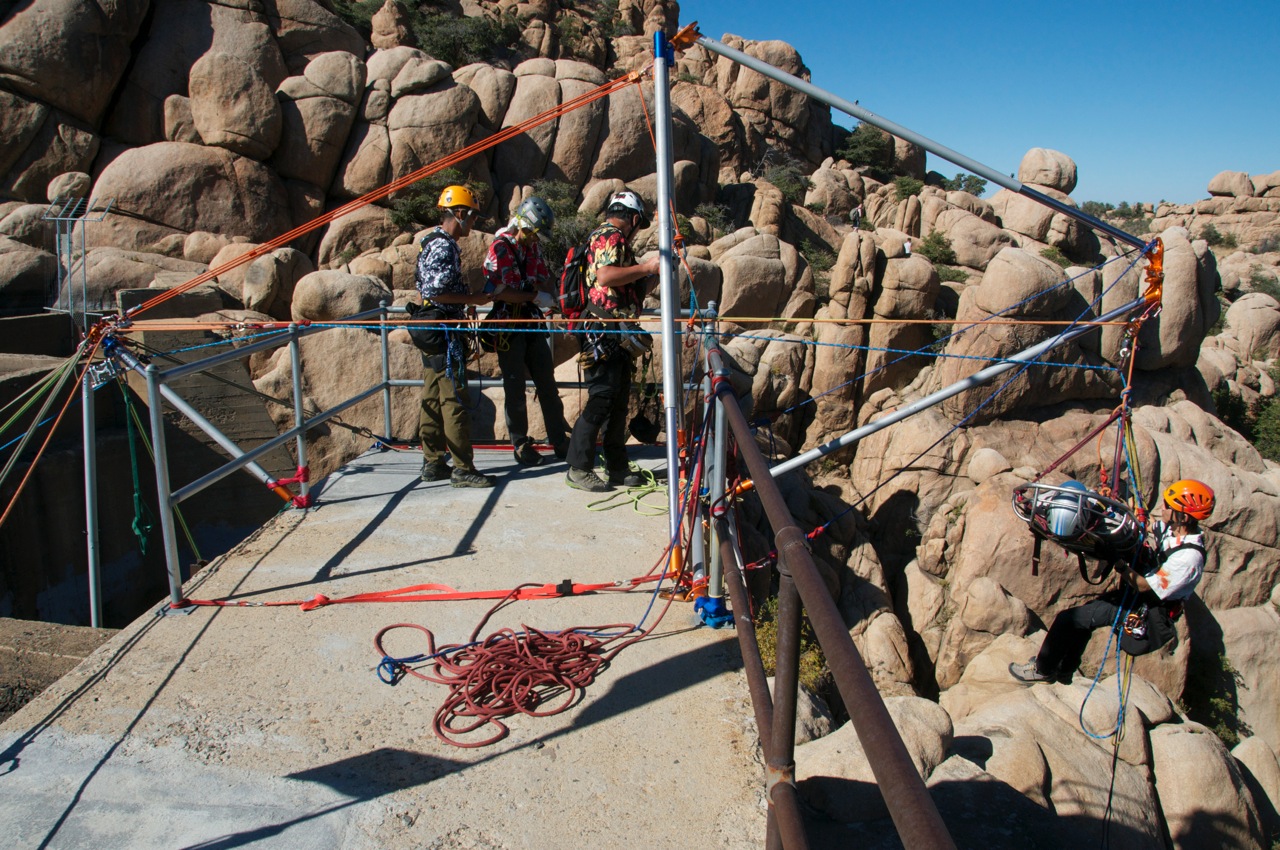
Below: Arizona Vortex program at Mt. Arapiles, Victoria, Australia in 2007.

Below: Arizona Vortex program at Wherepapa, New Zealand in 2005.

Below: 2014 program for all-Japanese students at Prescott Fire Training center.

Below: 2014 Double A frame set up at Tim's Toyota Arena in Prescott Valley, AZ

Below: 2014 Cantilevered A frame set up at Tim's Toyota Arena in Prescott Valley, AZ

-
AHDW Equipment List
-
OHRW
OFFSET / HIGHLINE RESCUE WORKSHOP
(See Current RTR Open Enrollment Schedule for when/where this program is offered) (NOTE: The OHRW is NOT offered each year) Read (or print) the most recent color information flyer on this workshop: HERE
For years, emergency rope rescuers and rope access technicians have asked for a training program on temporary rigging employing elevated rope tracking elements. The OFFSET / HIGHLINE RESCUE WORKSHOP is just the type of program where these elevated options can be explored in detail. The program looks at subtle, yet fundamental differences between the use of high angle offsets and drooping and/or reeving highlines for canyon/industrial locations where abundant high anchors are plentiful. Therefore, this is NOT a program that explores highly tensioned spanning elements (like the Kootenay Highline System) where high or full strength connections are mandated at either end, but rather only a look at other low tension highlines that can be used over gaps with higher anchorages. The OHRW is not an extensive highline workshop like the Advanced Skills Rescue Workshop (that program focuses on 100% highlines and the Kootenay Highline System).
The course begins with simple and easy to understand lessons on physics relative to ropes under tension used above the ground and how to keep spanning element anchoring forces low. The program moves between the subtle, yet substantial, differences between minor and major offsets and then moves into the distinctions between offsets and highlines. For rope access technicians, this course gives the student the groundwork for elevated transporting systems for men and/or materials used in work. The OHRW also has lectures on extensive pulley systems which are used to provide tension for these aerial rope highways. More than just a "highline" seminar, the OHRW provides a multiplicity of lower tension options for the rope rescue and rope access technician without the excessive training and discipline that a strict adherence to the Kootenay Highline System. Additionally, the program is taught in an environment conducive to this kind of discipline. This is NOT a rescue course only. While the techniques can be applied to rescue work and often are, these methods may be used in any rope access endeavor. The real difference is that when human loads are applied, secondary safety lines must be employed at all times throughout the process of movement.
-
OHRW Key Points
KEYPOINTS
Read (or print) the most recent color information flyer on this workshop: HERE
- This program deals with a comparison between offsets and the use of low tension highlines for spaning canyons or industrial gaps
- Physics of rope rigging with emphasis on tension forces relative to tracking elements
- Acute differences between offsets and highlines (physics)
- Ideal for rope access technicians (those that work at elevation)
- Low tesnion highlines with higher side to side anchorages
- Anchor building - system anchors
- Knotcraft - basic through advanced
- Introduction to pulley systems (simple through complex)
- Moderate use of simpel to intermeidate frames (Arizona Vortex)
- Critical analysis of tracking elements-critical point test
- Major high angle offsetting:
- Skating tracking lines (belayed and self belayed)
- Deflection liness (belayed and self belayed)
- Two rope pendulum offsets (belayed from both sides)
- Limited highlines (only those with high anchorages and more than 15% sag) (NOTE: This is NOT a full highline program)
- Low tension reeving highlines (carriage belayed from both sides -reeve line belay options)
- Low tension drooping highlines (belayed from both sides)
-
OHRW Details
7 Days - Some days are up to 10 to 12 hours in length 12 StudentsModerately DifficultClassroom 25%, Practicals 75%Prerequisites: None. (Prior rope rigging experience strongly recommended)
Read (or print) the most recent color information flyer on this workshop: HERE
Get: RTR Application
Go to: Registration Information
Find out tuition and when and where offered: See Schedule -
OHRW Photos
OFFSET-HIGHLINE RESCUE WORKSHOP PHOTOSFrom Ropes That Recue collection. All photos copyright RTR ©1999/2022Read (or print) the most recent color information flyer on this workshop: HEREOFFSET OR HIGHLINE PERTINENT PHOTO: 2014 tracking line offset at Arizona's Watson Dam in the Granite Dells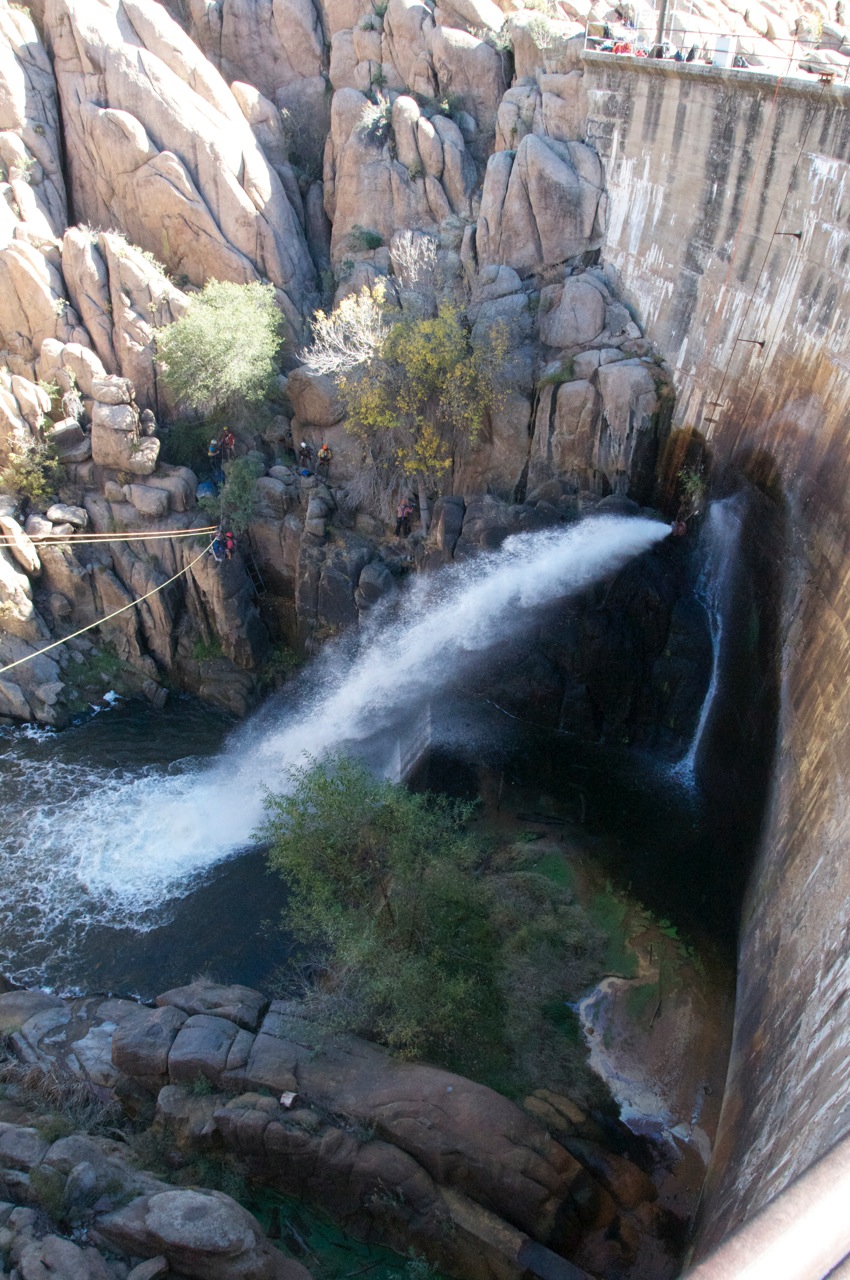 OFFSET OR HIGHLINE PERTINENT PHOTO: 2014 skate block offset during Maryland training at Dickerson Generating Station in Montgomery County with Mike Green, lead instructor for RTR
OFFSET OR HIGHLINE PERTINENT PHOTO: 2014 skate block offset during Maryland training at Dickerson Generating Station in Montgomery County with Mike Green, lead instructor for RTR OFFSET OR HIGHLINE PERTINENT PHOTO: 2014 two rope offset through a cantilevered A frame used at Tim's Toyota Arena in Prescott Valley, AZ
OFFSET OR HIGHLINE PERTINENT PHOTO: 2014 two rope offset through a cantilevered A frame used at Tim's Toyota Arena in Prescott Valley, AZ OFFSET OR HIGHLINE PERTINENT PHOTO: A two rope offset in front of Tumalo Falls near Bend, Oregon
OFFSET OR HIGHLINE PERTINENT PHOTO: A two rope offset in front of Tumalo Falls near Bend, Oregon OFFSET OR HIGHLINE PERTINENT PHOTO: Massive 200 meter tracking line offset onto roof of New Zealand Auckland Mall (far below) in 2005
OFFSET OR HIGHLINE PERTINENT PHOTO: Massive 200 meter tracking line offset onto roof of New Zealand Auckland Mall (far below) in 2005 OFFSET OR HIGHLINE PERTINENT PHOTO: 2014 Kootenay Highline over Deception Gulch, near historic Jerome, AZ
OFFSET OR HIGHLINE PERTINENT PHOTO: 2014 Kootenay Highline over Deception Gulch, near historic Jerome, AZ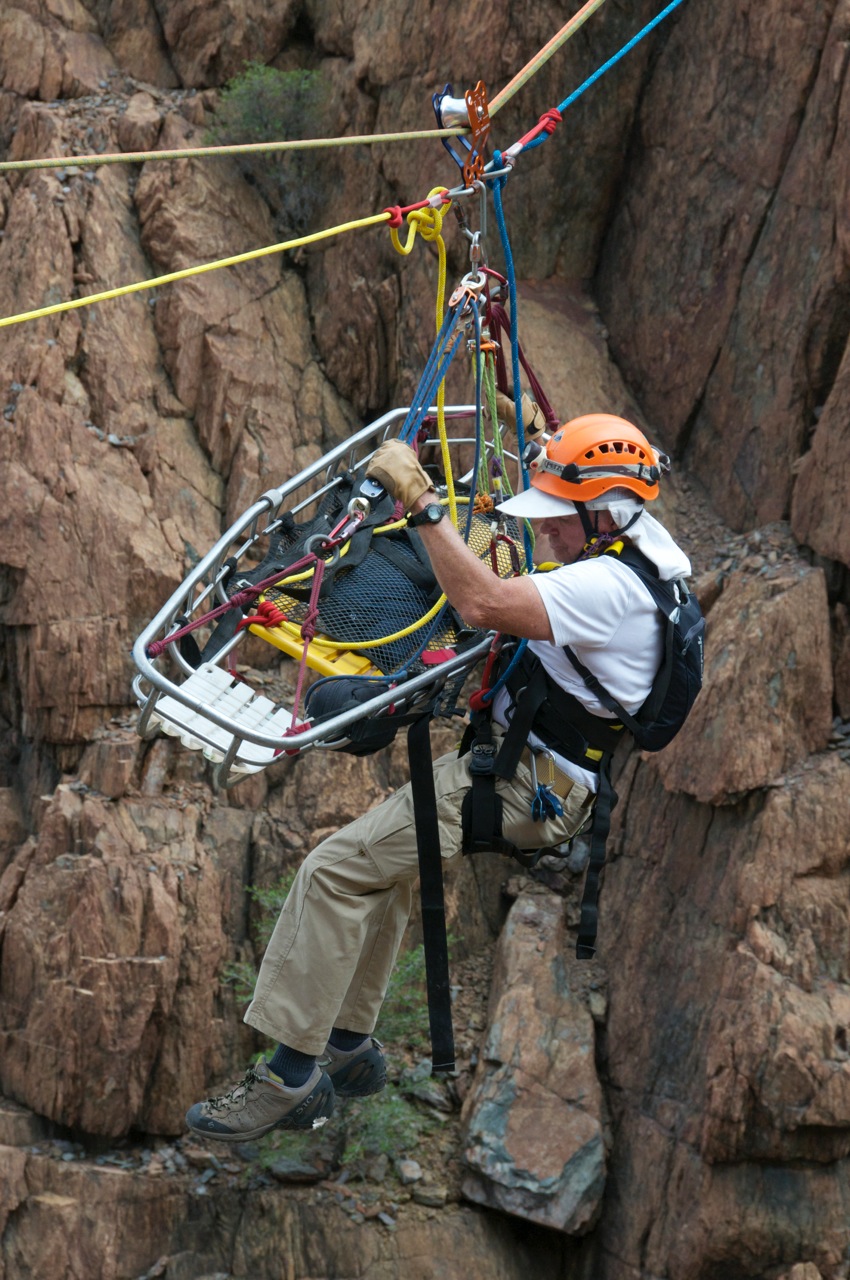 OFFSET OR HIGHLINE PERTINENT PHOTO: 2013 Skate block offset used at Mohonk Preserve in "Gunks" climbing area
OFFSET OR HIGHLINE PERTINENT PHOTO: 2013 Skate block offset used at Mohonk Preserve in "Gunks" climbing area OFFSET OR HIGHLINE PERTINENT PHOTO: 2011 skate block offset used at Sedona Fire District comunication towers
OFFSET OR HIGHLINE PERTINENT PHOTO: 2011 skate block offset used at Sedona Fire District comunication towers OFFSET OR HIGHLINE PERTINENT PHOTO: 2014 Kootenay Highline with Arizona Vortex SA frame set up over Deception Gulch, near historic Jerome, AZ
OFFSET OR HIGHLINE PERTINENT PHOTO: 2014 Kootenay Highline with Arizona Vortex SA frame set up over Deception Gulch, near historic Jerome, AZ
-
OHRW Equipment List
-
PSRW
PERSONAL SKILLS RESCUE WORKSHOP -
(See Current RTR Open Enrollment Schedule for when/where this program is offered) Read (or print) the most recent color information flyer on this workshop: General Venues, Alaska Venue or Ontario, Canada Venue
The Personal Skills Rescue Workshop is considered by many past students as our most enjoyable, interactive and physically demanding. There is no shortage of "on-rope" time at this workshop! The PSRW, and the Team Skills Rescue Workshop are the courses which fulfill the 90% solution on most rope rescues within industry and wilderness locations. It is designed for the serious rope rescue practitioner wishing to improve their personal rigging skill and capability. This workshop is sometimes mistakenly perceived as a beginning program due to the personal nature of many of the evolutions. In fact, it is for those that never seem to get enough on rope experience or time over the edge. The PSRW begins with valuable, yet simple definitions for belays, self belays, conditional belays and conditional self belays and how these differ in their engineering. It goes into important orientation on personally carried gear such as ascenders and descenders, self belay devices, Purcell prusiks, the all valuable AZTEK kit and other items essential to safety in the vertical realm and then moves into practical and fun-filled days where multiple one-on-one rope stations keep the practitioner busy throughout the day. We have many return students to this program!
There is also considerable time spent on rope learning to climb/descend rope by multiple methods (even improvised if you drop your friction appliance). Passing knots, deviations, rebelays, rope to rope transfers, aid climbing and problem solving are all part of the PSRW. Proficiency through repetition to mastery are encouraged. There is a very very strong emphasis on advanced knotcraft in this workshop! For those wishing to get additional specific training on rope access and perhaps eventual certification through the Society of Professional Rope Access Technicians (SPRAT.org) we recommend taking an RTR Rope Access Skills Workshop 1 or 2. See open enrollment schedule for date and location.
TOP-DOWN RESCUE:
Students in the PSRW practice their personal rescue skills and learn to work together as a semi-team (one or two rescuers) in successful retrieval of this patient in a non-threatening environment. These are found in the predominantly top-down Seven Minimalist Rescue Archetypes (7 MRA) that lay a groundwork for understanding how solo versus semi-solo rescues vary in their risk to the rescuer. Top-down rescue is easier as it relies on friction which is helpful at times. The PSRW goes well into often overlooked personal skills that are taken for granted on most rescue teams. The 7 MRA are therefore well suited for industrial and wilderness rescue team members. Some of these skills are repeated in the Mountain Rescue Workshop as well. Example being the Juneau, Alaska MRW in 2022.
BOTTOM-UP RESCUE:
There are three differing bottom-up rescue techniques that we offer to PSRW students. They are a bit esoteric, but they are valuable "personal" skills which most past students seem to especially appreciate. They totally rely, once again, on the AZTEK kit and also the hand tied Purcell prusiks (tied from one 10 meter piece of 6mm supple accessory cord). Also, unlike the top-down rescue techniques of the 7 MRA, here you are fighting friction. Therefore these are more difficult and require perseverance. Again, some of these skills are repeated in the Mountain Rescue Workshop as well. Example being the Juneau, Alaska MRW in 2022.
1) PITCH HEAD RESCUE: RTR took the well-known rope access “pitch head rescue” where the rescuer at the TOP or “head” of the pitch breaks into the line the victim is hanging on with their AZTEK set of fours, and establishes a progress capture in that line to bring the victim to the top of the pitch. They must also monitor the belay line up as well so the victim is on two solid points for the raising. If the victim is down 50’, the rescue will need to do this several times with the AZTEK until the victim reaches the top.
2) PITCH TOE RESCUE: RTR Lead Instructor, Keith Thorne came up with the name for the “pitch toe rescue”. It is the grand finale of the PSRW and the student really feels a sense of accomplishment when they finally complete it. The rescue (victim and rescuer) starts at the bottom, or “toe” of the pitch. The rescuer ascends the rope either in full ascent (Croll and handled ascender), or in half and half mode (half ascender and half descender with or without added pulley on handled ascender — which we jokingly call the “fat boy technique”) stretching out their AZTEK SO4s as they go with the orange ratchet engaged only. So, they are able to ascend upwards of about 12’ as that is all a SO4s will allow. The orange AZTEK pulley is attached to the top of the handled ascender. The blue AZTEK pulley goes to the victim. To ascend and not fight the prusik ratchet you must first pull all available rope through the top orange ratchet and let it dangle or pile it on the victims lap below. Once up the first 12’, attach second handled ascender (you can steal the one from the victim) to fair lead of AZTEK and use foot stirrup to pump away with leg, lifting victim up to your new position. The belay is managed also by the rescuer. Once victim is at your location secure them, and repeat the process until you are at the top with victim in tow. It is a good workout.
3) COUNTERBALANCE RESCUE: The "counterbalance" is an optional, however fun, personal skillset in the PSRW. It is really in between the pitch head and the pitch toe solo rescuer techniques. Once again you start with the rescuer at the anchor on top and the victim whatever distance below you hanging on rope. Rescuer uses both of their personal Purcell prusiks here in various configurations to transfer the anchored loaded line to the victim to their own rescue system. This involves the rescuer using their own mass hanging below a progress capture pulley to "counterbalance" the victim up as they go down. Rescuer must also manage belay for victim. Again, I don’t see this being a skill that students must complete for the PSRW at this time. However, things do change as the PSRW grows in difficulty.
Basically, the Personal Skills Rescue Workshop is a full-on solo & semi solo rescuer extravaganza. There is no framing, no litter work, no offsets, and no lecture other than to set forth the top down and bottom up scenario. Just the student on rope as a victim or on rope performing a rescue by their self.
Review of Michigan PSRW 2021 by Sean Porter-
I was recently enrolled in the Personal Skills Rope Workshop in Michigan and wanted to reach out and let you know about my experience. The class was fantastic and I learned a lot in a very short amount of time. It was by far one of the most challenging classes I have taken both physically and mentally. The weather provided some unique challenges but also added to the fun we had. I greatly enjoyed the time I spent in class and am looking forward to the next RTR class I can get into. Thank you for an amazing experience.Review of Michigan PSRW 2022 by Rachel Calderon-Murphy-Montgomery Coubnty Fire & Rescue, MDI continue to be amazed by how amazing your classes are! The knowledge, experience, and enthusiasm for the art of rope rescue and rigging each instructor brings to the table is unmatched! Before taking your classes, I thought I knew a fair amount and was extremely confident in my skills; after taking them I have absolutely become a more proficient and capable rope rescue technician, but they have also shown me there is so much to learn, and this is the group of guys I want to learn from!The Personal Skills workshop was the bread and butter to rescues on rope and skills to navigate those rescues. I loved how the instructor, Mike DeCreane, took skills that I had been doing and showed me where the roots of where they came from. The infamous “WHY” that Inquisitive minds search for! His teaching style showed a passion that was infectious and makes a student yearn for more! The venue in Michigan was perfect for the skills that we did. Gorgeous views! And while the weather left a lot to be desired; it didn’t for a second keep all of us from taking advantage and being a sponge for everything Mike had to give us! It’s a class I would do again and continue to learn from!Two thumbs up for this class and RTR! There really is nothing like it! It only takes one class for you to buy into the drug your selling; I’ll never look back!Review of Michigan PSRW 2022 by Ethan Foster-Kansas City Fire, KSRopes that Rescue workshops are informative, fun and unique in that they stress the ‘why’ of rescue that is so often left out. To me, they are more akin to a working vacation for a full seven long days which is their standard length program. There is a reason I continue to return time and time again. Additionally the instructors and liaisons are always extremely knowledgeable, helpful, patient and excited about the material too.The Michigan PSRW this spring was no exception. The skills covered were very applicable to rescue, particularly solo to semi-solo rescue operations. As the week progressed, working through the 7 Minimalist Rescue Archetypes helped to highlight, and enhance the understanding of the previous models while slowly introducing more elements or a slightly different way of performing the task. The skills learned, and reviewed, form a solid basis for work-at-height and I highly recommend anyone interested in such endeavors to get as much time on-rope in these areas as possible. I also believe that the first couple days of mostly lecture/class time are important as they lay the groundwork for the entire week and make sure all the students are on the same page.The venues for the recent Michigan training were great and facilitated a safe training environment while making morning and evening (some times quite late) transitions for break down and set-up easy. Certainly the weather did not cooperate for almost the entire week. I believe we got rain, hail, sleet, and snow…but these conditions simply added another interesting and intense tweak to the week. I think these hardships helped bring our small group together more by the end of the workshop. It was certainly something I doubt any of us will forget any time soon.One particular thing I have always noticed with RTR is the passion for the Art of Clean Rigging that is always present with instructors. Michael DeCraene is a perfect example of that. His knowledge and desire to share that knowledge bled through in everything that he did and hepushed us to become as detail oriented and proficient as we could. It is quite clear he has a love for high angle rescue and the Art Form. I would, without hesitation, sign up for another course lead by Mr. DeCraene.As usual, at the week’s end I am left wanting more, looking forward to my next workshop and end up browsing the online RTR schedule for the remainder of that year and into the next. The Michigan PSRW was my fifth RTR course and certainly will not be my last. I will continue to search out members of our rope rescue community who excel in high angle rescue in an effort to learn as much as I can from them. Ropes that Rescue is an organization at the top of that list.Thank you for sharing your passion, experience, and expertise with the rest of the community. I look forward to many more long days, late nights, and cold IPAs shared with like-minded individuals. -
PSRW Key Points
KEY POINTS
Read (or print) the most recent color information flyer on this workshop: General Venues, Alaska Venue or Ontario, Canada Venue
- Ideal for rope access technicians (those that work at elevation)
- Strong emphasis on personal skills
- Harness organization for working in vertical realm
- Anchor building using rock pro (active and passive)
- Anchor building using piton family (if available)
- Backtying and oppositon (front ties) and general rigging for anchoring
- Critical analysis of multi-point anchoring systems (understanding physics)
- Rope coiling methods
- Rope management to eliminate snarls and frustration
- Improvisation and minimalism "What do you do if the gadget does not show up?"
- Knotcraft to the extreme (There is a strong emphasis on knot skills)
- Introduction to pulley systems (partial lacture)
- Multiple methods of descending on rope (including improvised)
- Multiple methods of ascending on handled ascenders
- Passing knots on
on ascent and descent - Rope-to-rope transfers
on ascent and descent - Passing re-belays on ascent and descent
- Passing standard deviations against wall
on ascent and descent - Passing "flying" deviations (no wall) on ascent and descent
- Horizontal aid climbing (if avaialble)
- True belays and self belays
- Self rescue techniques / Buddy rescue techniques
- AZTEK kit orientation for personal and team operations:
- First 8 uses of AZTEK
- Single and double part hasty rappels (5 & 6)
- Belays and self belays (3 & 4)
- Dynamic fixed and traveling brakes
- Ascending with AZTEK in 2 parts (7)
- Personal travel restrict (1 & 2)
- Set of fours pulley system (8)
- Solo rescue: Complete Seven Minimalist Rescue Archetypes (7MRA)
- Solo rescuer pick off ("gecko" and hanging)
- Semi-solo rescuer pick offs ("gecko" and hanging)
Solo one-on-one rescues: - Pitch head rescue (breaking into lines on top with AZTEK and bringing casualty up from bottom)
- Pitch toe rescue (descending to bottom and attaching to casualty with AZTEK and ascending with them to top)
- Counter balance rescue (if time permists)(Using your own weight to advance someone up a cliff or drop)
- Lead climbing (optional)
- Down climbing techniques
- Sound anchoring principles: simple through advanced system anchors
- Rigging plates and pods using AZ Vortex, focused floating anchors made "bombproof" for over edge rope work
- Manual and auto stop friction appliances
- Slack backups vs tensioned backties
- Much more....
-
PSRW Details
7 Days - Some days are up to 10 to 12 hours in length 12 StudentsExtremely DifficultClassroom 25%, Practicals 75%Read (or print) the most recent color information flyer on this workshop: General Venues, Alaska Venue or Ontario, Canada Venue
Prerequisites: None. You must be in excellent physical condition to participate in this workshop. Climbing background strongly encouraged.
Get: RTR Application
Go to: Registration Information
Find out tuition and when and where offered: See Schedule -
PSRW Photos
PERSONAL SKILLS RESCUE WORKSHOP PHOTOSFrom Ropes That Recue collection. All photos copyright RTR ©1999/2022Read (or print) the most recent color information flyer on this workshop: General Venues, Alaska Venue or Ontario, Canada Venue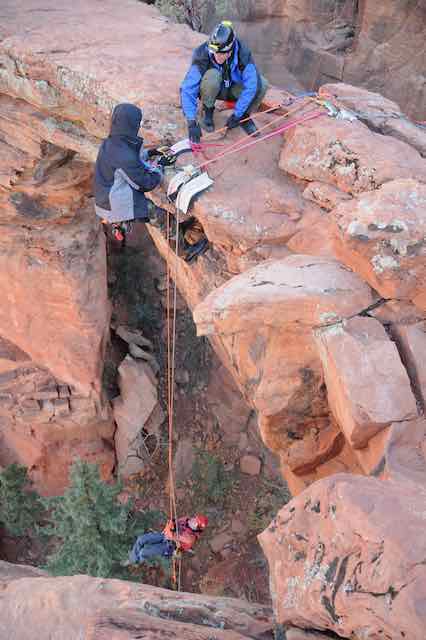
PSRW: Practicing solo rescue techniques on scenic Devil's Bridge, in Sedona, Arizona
Becky Cordova practicing lead climbing on the 730' high Forest Hill Bridge near Auburn, California during a PSRW in Roseville, CA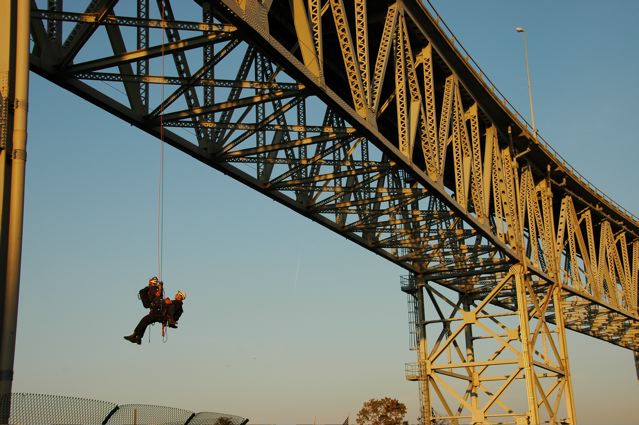
PSRW: Practicing one of the Seven Minimalist Rescue Archetypes off the Port Huron Bridge in Michigan PSRW at Thörne residence where students tie all three Purcell prusiks from one 33' piece of 6mm accessory cord.
PSRW at Thörne residence where students tie all three Purcell prusiks from one 33' piece of 6mm accessory cord. Rob Stringer of Australia on a tight rebelay duirng a PSRW in Sedona, AZ
Rob Stringer of Australia on a tight rebelay duirng a PSRW in Sedona, AZ PSRW: Darrell Coats performing a two rope Dulfersitz rappel in Sedona, AZ
PSRW: Darrell Coats performing a two rope Dulfersitz rappel in Sedona, AZ
Hawaiian Shirt Day PSRW: Darrell Coats performing an improvised carabiner brake rappel in Sedona, AZ
PSRW: Darrell Coats performing an improvised carabiner brake rappel in Sedona, AZ
Hawaiian Shirt Day "GUNKS" PSRW: Helen Curan and Frank Tkac of Mohonk Preserve in New York perform a pick off during a PSRW
"GUNKS" PSRW: Helen Curan and Frank Tkac of Mohonk Preserve in New York perform a pick off during a PSRW
Hawaiian Shirt Day PSRW: Practicing one of the Seven Minimalist Rescue Archetypes off Devil's Bridge in Sedona, AZ
PSRW: Practicing one of the Seven Minimalist Rescue Archetypes off Devil's Bridge in Sedona, AZ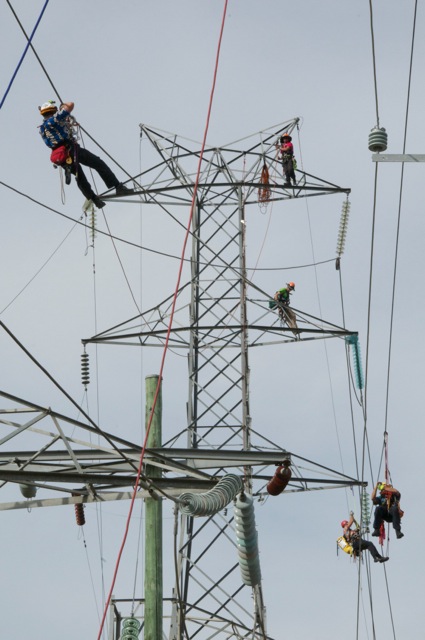 Tasmania, Australia PSRW with Tasmanian Fire Service
Tasmania, Australia PSRW with Tasmanian Fire Service
Hawaiian Shirt Day Kevin Frye practicing a deviation in Sedona, AZ
Kevin Frye practicing a deviation in Sedona, AZ -
PSRW Equipment List
-
TSRW
(See Current RTR Open Enrollment Schedule for when/where this program is offered) Read (or print) the most recent color information flyer on this workshop: UK Venue
The Team Skills Rescue Workshop is ideal for industrial and wilderness rescue teams and is designed to begin where the Personal Skills Rescue Workshop leaves off and carry on into more demanding rescue practices and team-building skills. This, and the PSRW, are the workshops which fulfill the "90% solution" on most rope rescues within industry and wilderness locations. Lectures on intermediate physics and how it relates to rope rigging are common throughout the duration of this workshop. Emphasis is places on "why" we do something, rather than "how". Students, as a team unit, learn how to build seemingly complex arrangements for reaching, treating and extricating a patient from the vertical high or steep angle environment whether in industrial locations or in the wilderness. All the while, emphasis is placed on building everything from the basic materials most teams will have along: rope, carabiners, pulleys, accessory cord, webbing and know how.
The Team Skills Rescue Workshop focuses on these main areas:
- Anchoring:
This would include so called "bombproof", substantial and marginal (contributory) anchors and anchor systems. It also covers anchor plates, rigging pods, bipods and tripods (AZ VORTEX if applicable). In some TSRW, rock protection is thoroughly practiced within the program (if applicable). - Physics:
"Barn floor physics" (as opposed to "loft" physics) lessons on anchor loading and directional loading are done in the classroom on the whiteboard. A favorite part of the TSRW for many as it brings home the importance of understanding force (compression and tension). These lectures reinforce the upcoming lectures on artificial high directionals with relevant discussions on component force vectors and resultant force vectors - Pulley Systems:
Pulley system understanding is key to understanding what is happening in our rope systems. We delve into class 1, 2 and 3 pulleys. working and non working systems, simple, compound and complex pulley systems. We also cover the Arizona Progression of 7, a series of learn-by-rote pulley systems for the general rescue practitioner. Also, these systems produce differing loading on our anchors so attention is paid to tension units as well - High Directionals: (AZ VORTEX or other)
This includes, in most TSRW, the use of the Arizona Vortex (frame) as a tripod, bipod and monopod at the edge and for anchors back from the edge (see "Anchors" above). Extensive lectures on the basic setups for this appliance found in the User Manual. Extensive guying section for frames with the use of non-working pulley systems. - High Angle Offsets:
The TSRW includes an extensive lecture and practical section on alternatives to highlines in the form of "offsets". Ropes That Rescue has become known for its projection of these offsets as an alternative to training intensive highlines in the past 25 years. Offsets employ standard high angle techniques that most rescuers already know and so are more forgiving in the training curve than more elaborate systems. These offsets are: 1) Tag Line, 2) Guiding Line, 3) Tracking Line, 4) Skate Block, 5) Deflection Line, 6) Two Rope.
NOTE 1: Highlines are NOT covered in this program. If desired, please see Advanced Skills Rescue Workshop
NOTE 2: Limited steep angle litter evacuations in this program. If desired, please see Tactical Wilderness Rescue Workshop
NOTE 3: Limited personal skills other than the first 8 uses of the AZTEK. For personal skills see Personal Skills Rescue WorkshopThe Team Skills Rescue Workshop is not by any means a beginning rope rescue program. It is a serious venture and complete immersion into rescue systems that can sometimes be overwhelming to some less experienced practitioners.
Here is a testimonial from a Search and Rescue student in Utah: The Team Skills Rescue Workshop was enjoyably challenging. Too often, we teach our teams how to do something without teaching them why we do it a particular way. Reed spent a lot of time explaining the why behind the how. Without understanding the physics behind a procedure, most teams are unable to adapt their rigging to non-textbook rescue scenarios. If we were exposed to procedures in the seminar that differed from our SOPs, the instructors supported the RTR procedures with exceptionally sound mathematical and practical justification. Comparative analysis of various systems was enlightening.
RTR's abilities to tailor the training to a particular group was much appreciated. A team charged with backcountry rescue needs different training, equipment, procedures, etc., than an industrial rescue team. Reed seemed to have a genuine desire to show us ways we could decrease the amount of weight and bulk carried into the field without compromising system safety. Again, all his suggestions were supported with sound mathematical and practical justification. As a result, our team will be altering (and improving) some of it's rigging procedures.
Frank Mendonca
UTAH Grand County SAR - Anchoring:
-
TSRW Key Points
KEY POINTS
Read (or print) the most recent color information flyer on this workshop: UK Venue
- Safety factors / Safety margins
- Strong emphasis on team-oriented skills
- Knotcraft
- Intermediate pulley systems (simple through complex)
- Physics of rope rescue
- Two tensioned rope systems analysis
- Artificial high directions:
- Gin pole monopods
- A frames
- Sideways A frames
- Easel A frames
- Directionals and anchor angle force calculations
- Batwing compound pulley systems-AZ Progression
- Complete AZTEK kit orientation for team operations:
- Single and double part hasty rappels
- Belays and self belays
- Dynamic fixed brakes
- Dynamic directionals
- Personal travel restrict and fall protection
- Mid face attendant-based and team-based litter scoops
- Team-based pick offs
-
Belays, self belays, conditional belays and conditional self belays
- Sound anchoring principles: intermediate through advanced system anchors
- Focused and focused-floating anchors using opposition anchors
- Patient tie in techniques
- Hot and cold changeovers
- Non-highline solutions to rescue scenarios
- Offsets for the high angle evacuation:
- Tag and guiding line offsets
- Deflected offsets
- Tracking line offsets
- Skate block offsets
- Two rope offsets
- Much more....
-
TSRW Details
7 Days - Some days are up to 10 to 12 hours in length 12 Students (or more with second RTR instructor)Moderate to Difficult - Depends largely on venue location.Classroom 30%, Practicals 70%Read (or print) the most recent color information flyer on this workshop: UK Venue
Prerequisites: None (Prior rope rigging experience strongly recommended)
Get: RTR Application
Go to: Registration Information
Find out tuition and when and where offered: See Schedule -
TSRW Photos
TEAM SKILLS RESCUE WORKSHOP PHOTOSFrom Ropes That Recue collection. All photos copyright RTR ©1999/2022Read (or print) the most recent color information flyer on this workshop: UK Venue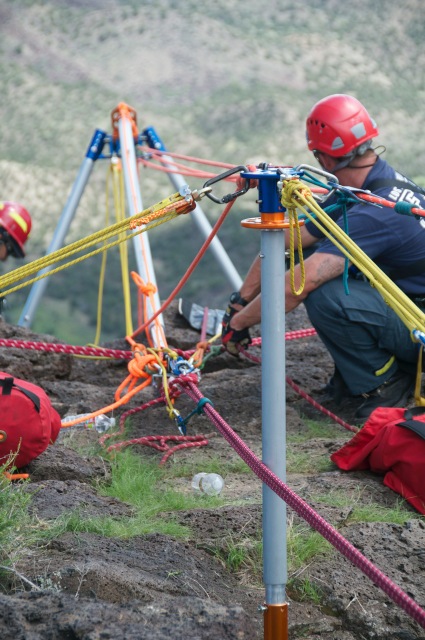 TSRW in Los Alamos, New Mexico. Many uses for the Arizona Vortex. 2014
TSRW in Los Alamos, New Mexico. Many uses for the Arizona Vortex. 2014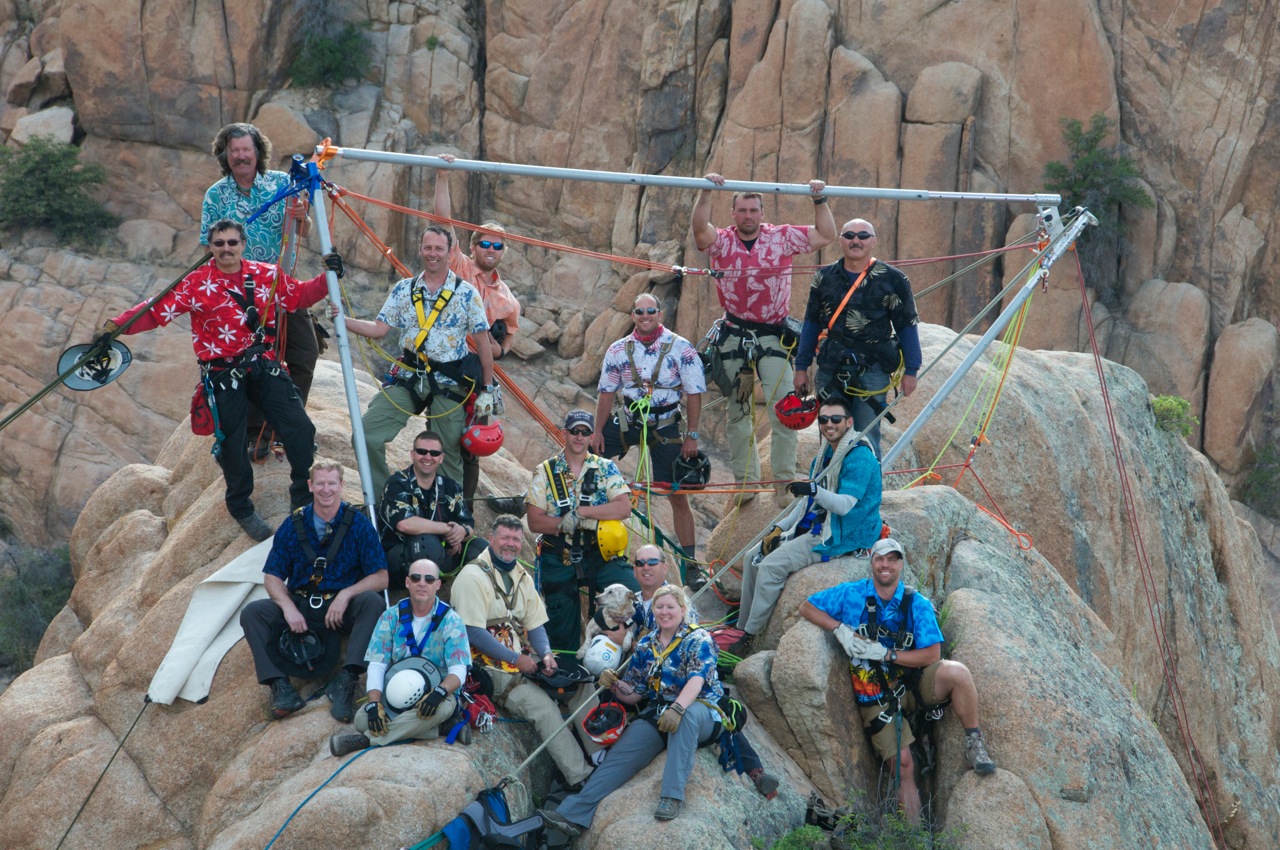 TSRW Hawaiian Shirt Day in Granite Dells, Prescott, Arizona with Reed and Keith Thörne as instructors (top row) 2017
TSRW Hawaiian Shirt Day in Granite Dells, Prescott, Arizona with Reed and Keith Thörne as instructors (top row) 2017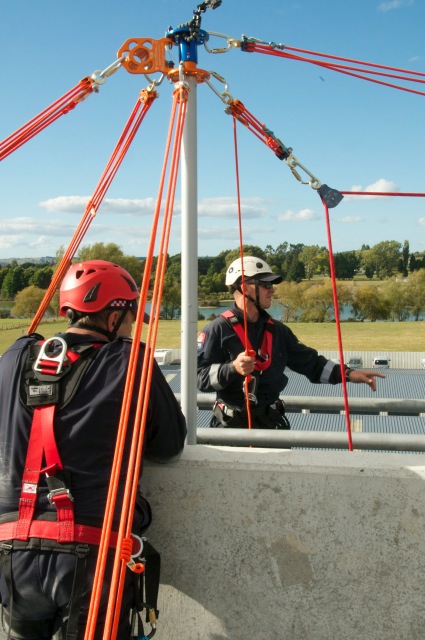 TSRW with New Zealand Fire Service instructors during contract RTR program 2015
TSRW with New Zealand Fire Service instructors during contract RTR program 2015 TSRW at Windy Point at Lake Abraham, Alberta ,Canada 2017
TSRW at Windy Point at Lake Abraham, Alberta ,Canada 2017 Keith Thorne working with Reed in Japan TSRW Kagawa Prefecture 2017
Keith Thorne working with Reed in Japan TSRW Kagawa Prefecture 2017 Len Batley and Reed Thorne teach a two deflection offset at the famous Athabasca Falls along the Ice Field Parkway in AlbertaHawaiian Shirt Day 2018
Len Batley and Reed Thorne teach a two deflection offset at the famous Athabasca Falls along the Ice Field Parkway in AlbertaHawaiian Shirt Day 2018 Reed Thorne (far right) teaching a deflection line offset in a TSRW at the Mount Robinson Tramway in Juneau, Alaska far above the Lynn Canal. 2021
Reed Thorne (far right) teaching a deflection line offset in a TSRW at the Mount Robinson Tramway in Juneau, Alaska far above the Lynn Canal. 2021 TSRW at the "Gunks" climbing area in the Mohonk Preserve near New Paltz, New York. Vortex is being used as a jamb pole and a leaning A-frame 2016
TSRW at the "Gunks" climbing area in the Mohonk Preserve near New Paltz, New York. Vortex is being used as a jamb pole and a leaning A-frame 2016 TSRW at Grand Coulee Dam Powerhouse #3 in a deep equipment shaft 2004
TSRW at Grand Coulee Dam Powerhouse #3 in a deep equipment shaft 2004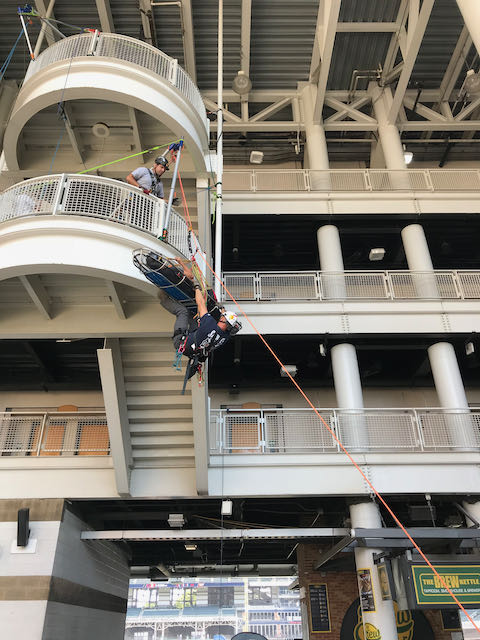 TSRW tracking line offset at Cleveland Progressive Field baseball arena 2020
TSRW tracking line offset at Cleveland Progressive Field baseball arena 2020 TSRW Arizona Vortex frame at edge of Niagara Falls, in Ontario, Canada 2021
TSRW Arizona Vortex frame at edge of Niagara Falls, in Ontario, Canada 2021 TSRW showing a river left deflection line offset. RTR instructor Luke Thorne at Tumalo Falls, near Bend, OregonHawaiian Shirt Day
TSRW showing a river left deflection line offset. RTR instructor Luke Thorne at Tumalo Falls, near Bend, OregonHawaiian Shirt Day Above and below:Keith Thorne prepares to rappel over the edge and be scooped by Seattle Fire RESCUE 1 team members during contract TSRW on Port Cranes in 2005.Extensive use of the AZTEK and Arizona Vortex here.
Above and below:Keith Thorne prepares to rappel over the edge and be scooped by Seattle Fire RESCUE 1 team members during contract TSRW on Port Cranes in 2005.Extensive use of the AZTEK and Arizona Vortex here.
-
TSRW Equipment List
ADVANCED SKILLS RESCUE WORKSHOP
-
ASRW
ADVANCED SKILLS RESCUE WORKSHOP -
(See Current RTR Open Enrollment Schedule for when/where this program is offered) (NOTE: The ASRW is NOT offered each year) There are prerequisites for enrolling in this workshop. It is NOT entry-level. The Advanced Skills Rescue Workshop is held only one time during any given year (sometimes skipping a year) and is a seven day workshop dealing with the remaining "10% Solution". This rigorous course "for wizards" builds upon some aspects of the Team Skills Rescue Workshop yet goes well beyond these both in intensity of rigging, and application of physical principles. The workshop begins on day one with an impromptu field exercise to assess existing skill level within the student "team". Emphasis is placed on low tech solutions to rescue scenarios before heading into technical solutions in the form of highlines. The workshop then explores all the available possibilities for setting up a horizontal, sloping or steep highline for removing, transporting or inserting rescuers or a patient. The ASRW is different from the Offset/Highline Rescue Workshop in that it is not 'entry level' (having no prerequisites) as highlines are greater than 150 degrees (much less sag) and following the Kootenay Highline System originally taught by Arnör Larson of the British Columbia Council of Technical Rescue (BCCTR). These are high tension highlines with very little sag and are ideal for rivers and places where high river bank anchors are not readily available. The ASRW also go into the many forms of reeving highlines including the English and Norwegian varieties and the discreet, subtle differences in the two. Single and double carriage litter rigging is covered along with passing both through an intermediary mid station on a long highline (called a "litter bypass"). Rule of Thumb techniques for determining the pre-tension on a single, twin or quadruple trackline highline are covered in detail if a strain gauge is not available. Use of a strain gauge (like the Rock Exotica Enforcer) is advantageous for keeping the highline within safety margins, especially when post-tensioning with a mass in the middle of the highline. Pilot line, messenger line and all forms of multiple delivery systems are explored in this workshop.
This is by no means an easy workshop. and it is certainly not for everyone. It has lots of carrying, walking or hiking, pulling and general work which must be accomplished by the students and so expect lots of physical exertion in carrying the many pilot lines, messenger lines and 1/2" diameter ropes and specialized, normally very heavy, hardware to the highline site. The ASRW is very "venue" dependent as to how long the highlines will be during any particular workshop. There may be, and often is, huge variation between wilderness locations and industrial ones.
In the end, there is really nothing like riding on a long highline. Even a short one by comparison. It can be quite thrilling to do so and students seem to enjoy the final reward that after all the hard work, they actually get to enjoy the technology in action.
Prerequisties: You must have succesffully completed one of the following RTR wotkshops in order to enroll in the ASRW. Team Skills Rescue Workshop, Offset-Highline Rescue Workshop, Industrial Rescue Workshop, Artificial High Directional Workshop. Or, you must gain special acceptance (pernmission) from the ASRW Instructor.
-
ASRW Key Points
- Complete highlines:
- Standard transportation-type highlines
- Drooping highlines
- Swiftwater highlines
- Reeving highlines (for varying trackline angles)
- Extreme highlines over 600'
- Highline logistics and tear down
- Advanced pulley systems
- Various pilot and messenger delivery systems:
- Advanced anchoring for highlines
- High strength tie offs using mechanical and natural means
- Standard and advanced artificial high directionals:
- V frames
- Double A frames
- Over the edge AHD's
- Mid span litter package bypasses on transecting highline obstructions for single and double carriage yokes
- Hot loading (with patient in litter) double carriage litters on steep angle highlines
- Single, twin and quad trackline highlines
- Single and double yoke carriages
- Passing bends on the taglines
- Tagline prusik bypasses
- Tagline hanger variations
- Ideal and practical fall factors
- Sedona BC Drop Test data (1989: Larson, Thorne, Dill)
- Extreme litter lowers (>300')
- Much more...
- Complete highlines:
-
ASRW Details
7 Days - Some days are up to 10 to 12 hours in length 12 StudentsStrenuousClassroom 20%, Practicals 80%
Prerequisites: TSRW, IRW, OHRW or MRW (or special permission from the instructor)
Note: This program not always offered in each calendar year.Get: RTR Application
Go to: Registration Information
Find out tuition and when and where offered: See Schedule -
ASRW-Photos
ADVANCED SKILLS RESCUE WORKSHOP PHOTOS
From Ropes That Recue collection. All photos copyright RTR ©1999/2022

Rancho Cucamonga Fire Dept. (California) doing an English Reeve Kootenay Highline system between generator towers at the Etiwanda Generating Station.
The November 2007 2115" long Kootenay highline between Bell Rock and Courthouse Butte in Sedona, AZ
2 track rope Kootenay Highline in Deception Gulch, near Jerome, Arizona in 2016
2 track rope Kootenay Highline in Deception Gulch, near Jerome, Arizona in 2016
Sedona, Arizona is Red Rock Country! Here a 250 meter highline from the top of Devil's Arch to the red rock prominence below center right. Here we are practicing a difficult litter bypass through an Arizona Vortex A-frame.
Anchoring Arizona Vortex spreader bar for a series 12:1 pulley systems for tensioning a 2 track line Kootenay highline in Deception Gulch, Arizona in 2016
An English Reeving Kootenay highline at Alberta's Athabasca Falls (Canada) in 2017
Len Batley, Senior Lead Instructor for RTR in Australia at Mount Arapiles teaching a 220 meter sloping highline to the valley floor far below.
A litter bypass station (on a Vortex A-frame) on a 100 meter Kootenay highline at Mount Arapiles in 2011.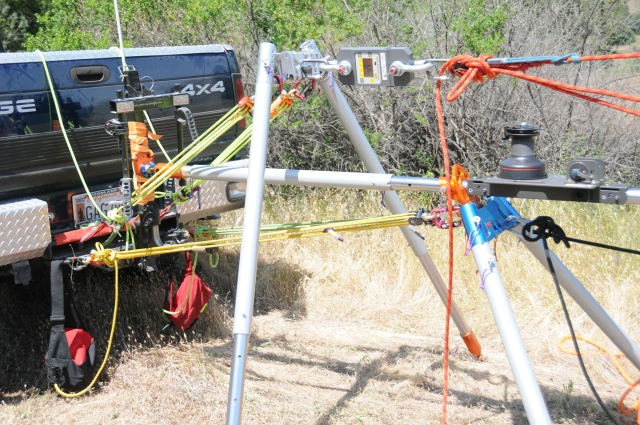
Track line anchoring bipod (above) and capstan winch anchoring tripod (below) anchored to a Dodge pickup truck during an ASRW in Cool Rock Quarry near Auburn, California in 2014
The 2150' long Kootenay highline from Bell Rock (foreground) to Courthouse Butte (distance).
Del Miller, Mississippi RTR assistant instructor on the far side of Deception Gulch in Jerome, Arizona during ASRW there in 2016 -
ASRW Equipment List
-
TWRW
TACTICAL WILDERNESS RESCUE WORKSHOP -
(See Current RTR Open Enrollment Schedule for when/where this program is offered) Read (or print) the most recent color information flyer on this workshop HERE
Ideal for REMS (Rapid Extrication Module Support) Teams. The TWRW seeks to explore solution for a safe and efficient minimalist wilderness rescue. It is designed for the serious wilderness SAR practitioner wishing to improve their personal rigging skill and capability in the backcountry, off the beaten path and definitely out of bounds. And it is made to be quickly done with no huge systems.
If you were looking for a quality 7 day long workshop which teaches all these essentials for flat, low and steep angle rudimentary rescue below high angle (<60 deg) this is your opportunity. There are limited, light weight high directionals (including the use of logs as such), limited rigging pods as required and unnecessary rigging is missing. It is all similar to what we do in slot canyons—all improvisation from anchors built from available features and flora on site. Thinking outside the box is a key element here. The TWRW then seeks to explore solution for a safe and efficient minimalist wilderness rescue. It is designed for the serious wilderness SAR practitioner wishing to improve their personal rigging skill and capability in the backcountry, off the beaten path and definitely out of bounds. And it is made to be quickly accomplished with no huge, time consuming systems.
We will be using smaller diameter “hybrid” ropes in the TWRW with exceptional strength with abrasion and cutting resistance. The option of using larger ropes up to 11.1mm (7/16”) diameter in this program is certainly acceptable but this program is trying to decrease the amount of gear and rope needed to pull off a rope rescue quickly. We use a break-apart titanium litter which is perfect for this due to its light weight.
We will build the ever popular and light weight Purcell prusiks (from one piece of 6mm accessory cord) for use on our smaller ropes where traditional ascenders will have limited applications. We will opt to leave behind all the heavy metallic gear but some students will still be welcome to use their MPD®, Maestro® and Clutche® if they so choose. We can use many different options to apply friction to the particular diameter rope we are using for lowering a litter + 1, 2 or 3 bearers down an embankment. That is part of thinking outside the box. The TWRW will eventually move into the field for the last part of this program hanging on improvised anchor systems students build and knots students tie. That is the fun of it! Students in this program learn to work as a cohesive team, working together towards the successful retrieval of an injured casualty in a non-threatening environment.
This workshop is taught by two backcountry wilderness rescue veterans: RTR Senior Lead Instructor, Reed Thorne along with visiting master guest instructor, Dale Stewart of AHS Rescue in Phoenix. Dale is well versed in REMS operations and brings a wealth of know-how and understanding to the TWRW program.
NOTE 1: High angle litter evacuations are NOT covered in this program. If desired, please see Team Skills Rescue Workshop
NOTE 2: Limited personal skills other than the first 8 uses of the AZTEK. For personal skills see Personal Skills Rescue WorkshopWhy is this the Tactical Wilderness Rescue Workshop (TWRW) needed? And better yet, WHY Now?
RTR’s Reed Thorne explains:“My rope rescue career began briskly in this vertical wonderland and I was made the captain and eventual battalion chief of the Sedona Fire Districts Technical Rescue Team for almost two decades. If you have been to Sedona/Oak Creek Canyon you know the unbelievable red rock terrain is what draws the tourists from around the globe. The areas massive red walls are the top 1/3 of the famous Grand Canyon farther north. Hence, the need for a robust rope rescue team. As was then, today the SFD is a part fire department rescue AND wilderness mountain rescue team. They do both.
I noticed early on that the vast majority of the rope emergencies during my tenure were flat carry-outs, low angle and steep angle operations. In fact, I often comments that like most teams in mountainous terrain, the so called “bread and butter” of our call outs are flat, low or steep angle. Very seldom ever a high angle evacuation. While flat carries and low angle are what I call “non-technical evacuations”, the steep angle evacuation can indeed be “technical” in nature due to the exposure involved. These essential rescue techniques are vital to a wilderness team but lack the glamour and glitz of the jaw-dropping, awe-inspiring high angle litter evac. The majority of RTR workshops deal with high angle only. It has a “draw” that seems to fill programs. In this first time program, we are returning to the “bread-and-butter” or more accurately, the ESSENTIALS of wilderness rescue. The TWRW is all things which most will actually use. No high angle.
So, a decision has to be made whether the operation will be one or two ropes. This is what the TWRW is all about. An intelligent decision-making process. But rest assured, you will challenged to make the right choice. This program is about down-to-earth, nitty-gritty rescue. Things like simple role rotation for long carry outs, caterpillar passes of a litter down a steep embankment with only a simple belay line. Basic frictions hitches, rudimentary tree wraps, and anchoring….all basic, but essential.”
Testimonial from March 2023 TWRW participant:
As a rope rescue technician and leader who works primarily in backcountry or wilderness contexts, I gathered several key takeaways from the Tactical Wilderness Rescue Workshop. The area I typically patrol is mostly low angle and steep angle terrain. Our team size is typically between 3 to 5 technicians, and we are limited in what we can carry with us on foot to the incident. Reed’s thorough discussion of anchors and forces has helped to inform my decision making on which anchors to select and use for a rapid extractions. The discussion of materials and techniques during the course has given me a better handle on what rescue gear to purchase in the future and how best to employ a minimalist kit. The Ropes That Rescue method of one attendant litter guiding in steep terrain is a technique I plan to implement immediately with my team. These learnings, coupled with ample time to practice setting up and running minimalist style systems, give students a broad understanding of minimalist rescue techniques.
Daniel Bolin
TRR Instructor/ Team Lead
-
TWRW key points
Read (or print) the most recent color information flyer on this workshop HERE
KEY POINTS
- Primary knotcraft (what can be tied quickly/easily?)
- Minimalist, rapid-response wilderness rescue. Plain and simple!
- Ropes, carabiners, pulleys, slings, hitches, plates being used in a minimalist rescue (what can be used quickly?)
- Strong emphasis on personal mountain or wilderness rescue skills (what can be improvised quickly?)
- Coiling rope, rope management skills (how can I work with no tangles off a coil with no bag?)
- Flat carries (multiple techniques) 4 and 6 person
- Low angle non-technical evacuations
- Steep angle non-technical and technical evacuations (one rope versus two rope systems)
- Anchoring improvisation and minimalism (how can I use what is there when I arrive?)
- Introduction to pulley systems for minimalism (how can I use the AZTEK set of fours for all my raises?)
- Litter work in steep angle terrain (how can I minimize force on a lower/raise system to reduce exposure?)
- Focus on having strong personal skill with keen eye to risk management and awareness
- Understanding when and where a belay can or cannot be used (where can I reduce exposure and thus eliminate the belay line?)
- Complete AZTEK kit orientation for personal and team operations (first 8 uses of the AZTEK)
- Single and double part hasty rappels Belays and self-belays Dynamic fixed and traveling brakes
- Simple, compound and complex pulley systems for rapid extrication
- "Barn floor" physics lessons for the lay person (easy to understand)
- Anchor angle and directional lecture
- Whiteboard analysis of lowering and raising systems
- Personal travel restrict and fall protection (AZTEK)
- Downclimbing techniques for easy sloping, sloping and steep rock (how can I get down safely?)
- Complete Purcell Prusiks tied from one piece of accessory cord
- Utilizing non-rescue team personnel for hauling, carrying, etc.
- Litter carry role rotation to save strength for long carry outs
- Shoulder sling support on 4/6 person flat/low angle litter carries
- Steep angle “caterpillar pass” techniques for a litter with a simple safety line on litter
- Split coil carries of slightly injured or ill casualties
- Much more…
-
TWRW Details
7 Days (expect 8 or more hours per day) Evening operations can be expected Moderately difficult (Expect rough rocky terrain! Good footwear is mandatory for safety)Classroom 30%, Practicals 70%Read (or print) the most recent color information flyer on this workshop HERE
Go to: Registration Information
Find out tuition and when and where offered: See ScheduleThis workshop is taught by two backcountry wilderness rescue veterans: RTR Senior Lead Instructor, Reed Thorne along with visiting master guest instructor, Dale Stewart of AHS Rescue in Phoenix. Dale is well versed in REMS operations and brings a wealth of know-how and understanding to the program.
-
TWRW Photos
TACTICAL WILDERNESS RESCUE WORKSHOP PHOTOSFrom Ropes That Recue collection. All photos copyright RTR ©1999/2022Read (or print) the most recent color information flyer on this workshop HERE

Kerry Lee of Jerome Fire set up a beutiful multi-point anchoring system with one rope onto an SMC Vector monopod. The two back ties from the Vector forward were our main anchoring system which was deemed "bombproof" due to the redundancy involved.
Jason Supple of Jerome Fire is the single bearer for this raise on steep angle. Here he is above the litter and trying to steer it past obstacles on the slope.
Here we were trying to keep the litter bearer below the litter to see if steering was betteer accomplished. Use number 138 for the AZTEK kit.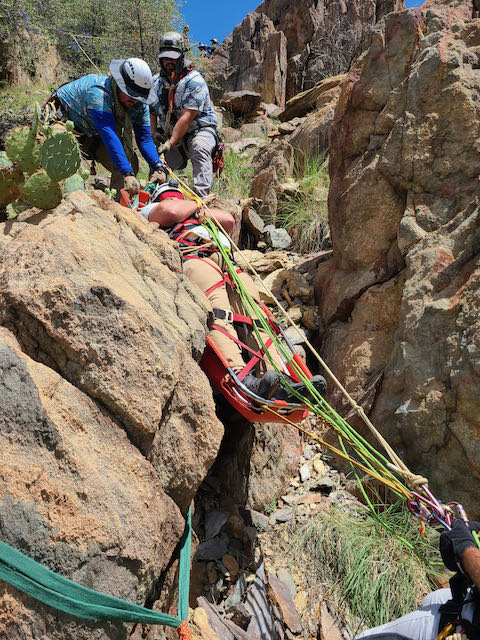
Negotiating the steep and rough terrain of the Granite Dells in Prescott.
The Vector by SMC used here as a monopod for the main "bombproof" anchoring system at the edge.
Rough ride for the victim (Russ Dodge of DPS). Much was learned in this program. 
The Vector by SMC used here as a monopod dirctional keeping the ropes off the embankment to prevent rock fall. 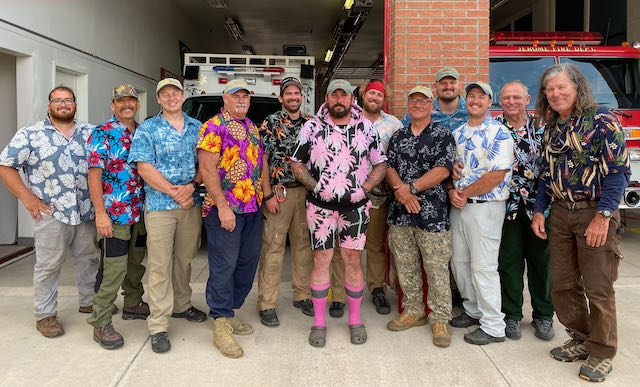
Hawaiian Shirt Day for the first ever TWRW in Jerome 2021. Visiting Guest Instructor, Dale Stewart (penultimate) and RTR Lead Instructor, Reed Thorne on far right. -
TWRW Equipment List


